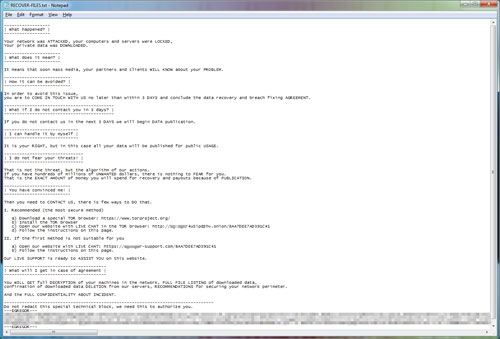Ransom.Win32.EGREGOR.YAAK-A
N/A
Windows


Threat Type: Ransomware
Destructiveness: No
Encrypted: Yes
In the wild: Yes
OVERVIEW
This Ransomware arrives on a system as a file dropped by other malware or as a file downloaded unknowingly by users when visiting malicious sites.
It drops files as ransom note. It avoids encrypting files with the following file extensions.
TECHNICAL DETAILS
Arrival Details
This Ransomware arrives on a system as a file dropped by other malware or as a file downloaded unknowingly by users when visiting malicious sites.
Installation
This Ransomware drops the following files:
- %Program Data%\dtb.dat → Contains machine generated RSA public key and encrypted RSA key.
- {Encrypted Directory}\{CRC32 of Netbios Domain Name}.lnk → Deleted afterwards
It adds the following mutexes to ensure that only one of its copies runs at any one time:
- Global\{Volume Serial Number + CRC32 Hash of Computer Name}
Process Termination
This Ransomware terminates the following services if found on the affected system:
- Services that contains the following string:
- database
- msexchange
- sql
- If --killRDP argument is used:
- Teamviewer
- TermService
It terminates the following processes if found running in the affected system's memory:
- agntsvc.exe
- dbeng50.exe
- dbsnmp.exe
- dumpcap.exe
- encsvc.exe
- excel.exe
- firefoxconfig.exe
- infopath.exe
- ipython.exe
- isqlplussvc.exe
- msaccess.exe
- msftesql.exe
- mspub.exe
- mydesktopqos.exe
- mydesktopservice.exe
- mysqld-nt.exe
- mysqld-opt.exe
- mysqld.exe
- ocautoupds.exe
- ocomm.exe
- ocssd.exe
- onenote.exe
- oracle.exe
- outlook.exe
- powerpnt.exe
- procexp.exe
- procexp64.exe
- procmon.exe
- procmon64.exe
- python.exe
- QBW32.exe
- QBW64.exe
- sqbcoreservice.exe
- sqlagent.exe
- sqlbrowser.exe
- sqlservr.exe
- sqlwriter.exe
- steam.exe
- synctime.exe
- tbirdconfig.exe
- thebat.exe
- thebat64.exe
- thunderbird.exe
- visio.exe
- winword.exe
- wordpad.exe
- wpython.exe
- xfssvccon.exe
Information Theft
This Ransomware gathers the following data:
- Computer Name
- User Name
- NetBios Domain Name
- Operating System Version
- Drive Type and disk space for each available drives
- Presence of Antivirus Product
- Volume Serial Number
Other Details
This Ransomware does the following:
- It requires the argument -pickyourmoney6 in order for it to continue with its ransomware routine
- It is capable of accepting the following arguments:
- --greetings="{string}" → Set greetings in ransom note.
- --append="{string}" → Set extension to append on encrypted files.
- --path="{Folder Path}" → Specify path to only encrypt.
- --norename → Does not append extension to encrypted files
- --nonet → Do not encrypt network drives
- --full → Encrypt both local and network drives
- --target="{string}" → Target file extension to encrypt. (Will avoid files with other extension but will still encrypt files without extension)
- --killrdp → Terminates TermService and Teamviewer Service. Disable RDP
- --samba → Created LNK files will not have "DELETE_ON_CLOSE" attribute
- --multiproc → Avoid creating Mutex (to allow multiple instance of malware)
- --fast="{size in MB}" → Specify file size limit for encryption in MB.
- --nomimikatz
- It checks for the computer's language and terminates itself if any the following language is detected:
- Armenian
- Azerbaijani
- Azeri
- Belarusian
- Georgian
- Kazakh
- Kyrgyz
- Romanian
- Russian
- Tajik
- Tatar
- Turkmen
- Ukrainian
- Uzbek
- It is capable of encrypting local and network drives.
- It deletes shadow copies.
- Due to the nature of how it drops its ransom notes, it is capable of printing physical copies of its ransom note through printers it has found in the network.
Ransomware Routine
This Ransomware avoids encrypting files with the following strings in their file name:
- dtb.dat
- autorun.inf
- boot.ini
- desktop.ini
- ntuser.dat
- iconcache.db
- bootsect.bak
- ntuser.dat.log
- thumbs.db
- Bootfont.bin
- RECOVER-FILES.txt
It avoids encrypting files with the following strings in their file path:
- \All Users
- \cache2\entries\
- \Low\Content.IE5\
- \Program Files
- \ProgramData\
- \Tor Browser
- \User Data\Default\Cache\
- \Windows
It appends the following extension to the file name of the encrypted files:
- {Original Filename}.{Original File Extension}.{Random Characters}
It drops the following file(s) as ransom note:
- {Encrypted Directory}\RECOVER-FILES.txt

It avoids encrypting files with the following file extensions:
- .exe
- .dll
- .lnk
- .sys
SOLUTION
Step 1
Trend Micro Predictive Machine Learning detects and blocks malware at the first sign of its existence, before it executes on your system. When enabled, your Trend Micro product detects this malware under the following machine learning name:
- Troj.Win32.TRX.XXPE50FFF038
Step 2
Before doing any scans, Windows 7, Windows 8, Windows 8.1, and Windows 10 users must disable System Restore to allow full scanning of their computers.
Step 3
Note that not all files, folders, and registry keys and entries are installed on your computer during this malware's/spyware's/grayware's execution. This may be due to incomplete installation or other operating system conditions. If you do not find the same files/folders/registry information, please proceed to the next step.
Step 4
Restart in Safe Mode
Step 5
Search and delete these files
- %Program Data%\dtb.dat
- {Encrypted Directory}\RECOVER-FILES.txt
Step 6
Restart in normal mode and scan your computer with your Trend Micro product for files detected as Ransom.Win32.EGREGOR.YAAK-A. If the detected files have already been cleaned, deleted, or quarantined by your Trend Micro product, no further step is required. You may opt to simply delete the quarantined files. Please check this Knowledge Base page for more information.
Step 7
Restore encrypted files from backup.
Did this description help? Tell us how we did.


